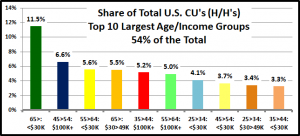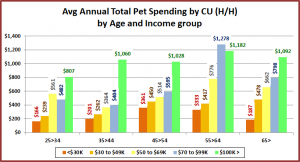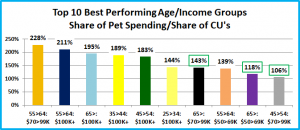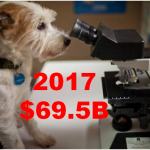U.S. Total Pet Spending – By Age AND Income Group
Using data from the annual Consumer Expenditure Survey conducted by the US BLS, we have done an in depth analysis of U.S. Pet Spending in over a dozen different individual demographic categories. This has given us a better understanding of “who” is behind the strength and continued growth of the Pet Industry. As always, the focus of the US BLS is on accuracy but at the same time they are never satisfied with the status quo. They are continually experimenting with new reports. This commitment to “make it better” is what led to the very timely and wildly popular demographic spending report by generation.
They’re at it again, producing a report that combines the two most popular and impactful spending demographic measures – income and age group. To get the required sample size, they combined the data from 2015 and 2016. As you recall, the Total Pet Spending for each of these years exceeded $68B. Unfortunately, because of the complexity of this test report we only have the numbers for Total Pet, not for individual industry segments…yet.
Even this “simplified” report requires a rather complex analysis. We have endeavored to keep it as simple as possible to make it easier to visualize and comprehend. The data is segregated into the following groups:
Age Groups
25 to 34 – All older Millennials
35 to 44 – All younger Gen Xers
45 to 54 – ½ Gen Xers & ½ Boomers
55 to 64 – All Boomers
65 & Over – 5 yrs of Boomers + older groups
Income Groups
Under $30K
$30K to $49K
$50K to $69K
$70K to $99K
$100K & over
This produces 25 subgroups, accounting for 98% of Total Pet Spending. The under 25 group is not included due to a very low share of Pet Spending and an extremely small sample size in the highest income levels. It is still very complex, especially in building graphs. Normally, a pie chart would be used to show the share of total CUs for each group. However, 25 slices of a pie, with 15 having a share less than 3%, make the chart unreadable. Therefore, we will focus on the largest, most impactful groups. Our first chart shows the market share for the 10 largest age/income segments.
- The economic division in the U.S. is very apparent as all the largest groups are either under $50K or over $100K.
- However, the division is strongly weighted towards lower incomes as 7 of 10 are under $50K – 5 of these are <$30K.
- The 2 largest segments of each of the 3 groups in the 35>64 age range are over $100K and under $30K.
- The oldest and youngest Americans have 4 of the 10 largest groups, all under $50K. (1/6 of all CUs are 65>, <$50K)
- There are no groups in the $70>99K range. Middle income America is obviously very fractionalized in terms of age.
It’s not all about income and age. There are other factors that impact Pet Spending. Two of the biggest are homeownership and family size, especially the number of children in the household. The following graphs show the distribution of these two demographics across income and age groups.
# of children under 18 – The financial pressure is high on lower and middle income Parents trying to fulfill the needs and wants of their human children and still be good Pet Parents. As expected, the vast majority of children are found in CU’s in the 25 to 44 year age range, especially the 35 to 44 yr old Gen Xers. Also, the number of children generally increases with CU income, except for Millennials. Their path is a bit of a roller coaster with the lowest number of children being in households with the highest income. We have all heard that Millennials are a little different. They are slow to leave their parents’ home, get married later, delay having children and are more likely to live in households with 2+ unmarried adults. These are all factors affecting the number of children in their households.
% Homeownership – About 83% of Total Pet Spending comes from Homeowners. Having more space that you control has always been a key to increased pet spending. Perhaps more than any other demographic, Homeownership regularly increases by age and income. For every age group, higher income means a higher percentage of homeownership. This is also true by income group as increased age shows increased homeownership, with one slight variation. There is a virtual tie for first at 94% by both over 55 groups, making $100K or more. The national homeownership average is 62%. You can see that the younger the group, the higher the required income to meet the average. It has been noted that Millennials are more likely to live in central cities and less likely to own a home than previous generations. This is reflected in the fact that they don’t reach the national homeownership average until their income exceeds $100K.
Now let’s get to the $pending. The next chart groups Pet Spending by income group so we can see if age matters.
- <$30K – This group represents almost 1/3 of all U.S. households and obviously has a financial struggle. The 45>64 year age group, which is ¾ Boomers spends noticeably more than the other groups.
- $30K>49K – With less family pressure the 45 and older groups increasingly focus on their Pet Children. Of note, the over 65 group takes the lead in household pet spending in this income range. The average retirees’ income is $40K. Once they reach this level, the financial pressure is reduced and they can increase their focus on their pets.
- $50>69K – Every group increases their Pet Spending but there is a big lift in the over 55 groups. Apparently this is a significant income threshold for them in terms of Pet Spending. We also see an incredible lift in the spending by the 25 to 34 year old Millennials. This could relate to that dip in the number of children that we saw earlier as well as the differences in the Millennial lifestyle.
- $70>99K – We have reached middle income. The over 55 groups show a big increase and in fact the spending of the 55 to 64 year olds takes off like a rocket. They become the overall #1 Pet Spending age/income group. The 35 to 44 group is still feeling strong financial pressure and remains in last place. The spending by the Millennials dips slightly but they are still 10% ahead of the 35 to 44 Gen Xers.
- $100K+ – Pet Spending explodes when income reaches $100K. The 55>64 year old group dips slightly but they still lead the pack. Perhaps the most significant increase (150%) comes from the 35>44 group. With some relief from financial pressure they can focus more on their pets. The only group under $1000 is the 25>34 year olds. However, their average over $100K income is 20% below the others so the $800 is on a relative par with the other groups.
Now let’s look at the same data from the age group view.
- Each age group seems to regularly increase Pet Spending as their income grows. Then, at some point they reach a significant threshold income and their Pet Spending doubles.
- For the 55 to 64 year old Boomers and the 25 to 34 year old Millennials, the critical point is $50 to 69K.
- For the oldest group, it comes at the lower $30>49K level. As we stated earlier, this is the average income for retirees and indicates a significant reduction in financial pressures.
- The 35 to 44 year olds have a different story. With the pressure from the largest families and in a critical phase of career building they don’t get any relief until their income passes $100K. When it does, they have a truly amazing response – a 150% increase in Pet Spending, moving up from last place to 3rd, trailing only the over 55 groups.
- Although the Boomers peak at a lower level, you can certainly see that an income of $100K+ is a universal magic number in Total Pet spending
Now, we will truly “show you the money”. Here are the top 10 groups in terms of Total Pet $pending.
- These 10 age/income groups account for 50% of all U.S. CU’s and 65% of Total Pet Spending.
- Money Matters Most as all age groups making $100K or more are included.
- Age is also a huge factor as 7 of the 10 groups are over 55 years old. (55>64 Boomers win with 4 groups)
- The 3 groups under 55 all make more than $100K
Finally, let’s look at the top performers which we will define as having the highest Share of Pet $/Share of CU’s. 7 are repeats from the chart above and have matching colors in the chart below. New additions are outlined in green.
- Once again age matters as only the same two under 45, over $100K income groups made the list.
- Although it seems impossible, money matters even more in Pet Spending performance than in Pet Spending $. There are no groups making under $50K. The 2 under $50K, over 65 age groups were replaced by 2 other over 65 age groups making from $50 to $99K. Even the 55>64 Boomers lost their <$30K group to a 45>54 middle income group.
The data in this report strongly reinforces the importance of age (life stage) and especially income in Pet Spending. The availability of disposable income results in increased Pet Spending for every age group. Pet Spending really explodes when any group’s income meets or exceeds $100K. For the lower income groups, the amount of available disposable income varies due to circumstances. The younger groups have more pressure due to family size and building a career. The 45>64 age groups have less family pressure. The over 65 folks just need to meet some low minimum income levels. One thing is certain for everyone. When disposable income increases, one of the first places that it gets spent is on pets.










Trackbacks & Pingbacks
[…] 上述資訊完整收錄於《U.S. Total Pet Spending – By Age AND Income Group》這篇文章中,對各年齡層、各收入曾在寵物上的消費力有更詳細的描述,有興趣的可以自行參考。 […]
Comments are closed.